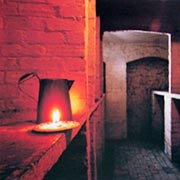Gentlemen
This article was researched and written by students on work experience placements.
Following breakfast, which was taken alone in the study, men involved in business would go out to work or be visited by clients. A more leisured gentleman would retire to his library to smoke his pipe and catch up with what was happening in the world, by reading the morning papers, such as "The Morning post" or locally the weekly "Sussex Advertiser" .

He might also have gone for a ride either in the local countryside or along the promenade. It was just as common for men to use the promenade as women. One prominent local man, Horace Smith, noted in 1828:
"If I mount my little white nag and ride from Kemp Town To Brunswick Terrace, I am sure of half a dozen invites to dinner. . ."
Riding was a very popular pastime among upper class men and the Prince Regent was often seen out riding with his attendants.
Upper class gentleman often frequented local 'gentleman's clubs' or coffee houses throughout the afternoon, meeting up with acquaintances and making new ones. It was essential to know and be seen with all the right people. Other activities included hunting - another popular upper class pastime and riding.

Before dinner the children would be put to bed and the gentleman and lady of the house would bathe and dress for dinner. If they were having guests, extra care would be taken with the outfit chosen. Before the meal sherry would be served in the drawing room and then guests would be summoned to the table when the food was ready.
After the main meal the women would withdraw to the drawing room to make the tea. Tea was incredibly expensive and servants were not trusted with it. The men stayed in the dining room to have port and smoke. It was thought rude to smoke in front of women so this was always done behind closed doors.
 The men also tended to get rather drunk and after the meal passed around the chamber pot under the table! It was common for young ladies of the house to entertain, performing musical pieces or by reading poetry. It was also common to go out for entertainment, for example to the opera or theatre.
The men also tended to get rather drunk and after the meal passed around the chamber pot under the table! It was common for young ladies of the house to entertain, performing musical pieces or by reading poetry. It was also common to go out for entertainment, for example to the opera or theatre.
Both the gentleman and lady of the house would start their day with a hot drink brought up to each of their bedrooms by one of the servants. After his drink the gentleman would attend to his 'toilet', ie: he washed and shaved. During the Regency men shaved with cut-throat razors sharpened on leather straps.
Teeth cleaning would have been done by all of the family with toothbrushes, toothpaste and toothpicks. Following this the gentleman would get dressed, assisted by his manservant. In the 1820s the ideal male form was that of a small waist coupled with a grand torso. To achieve this body shape men also wore corsets, made from whale bone, to pull in their waists and push out their chest. After the 1820s this body shape was accentuated further by coats being more fitted and padded around the chest and shoulder area. The suit was the most popular item of male fashion during the Regency period. It was worn for both formal and informal occasions, and even used as sportswear.
 It consisted of three main pieces:
It consisted of three main pieces:
Coat - In the morning the gentleman would wear a 'morning coat' this style was usually dark green and the tails had slopping edges.
Waistcoat - For day wear the waistcoat was the most decorative part of a gentleman's outfit. Red stripes were very popular and rich colours and embroidery were common. Attached to most waistcoats was a gold fob watch and chain nestling in a half crescent pocket.
The greatest change in menswear during the Regency period was the swap from breeches to trousers. This was an influence from the famous Beau Brummell who wore trousers with a strap underneath similar to present day 'ski-pants' which enabled them to keep free of wrinkles. Trousers were usually made from corduroy and buckskin. They were also skin tight resulting in many euphemisms emerging for them such as 'unwhisperables' and 'unmentionables'.



